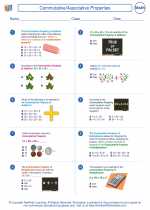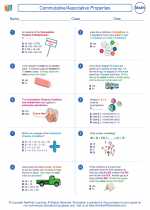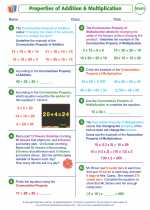Commutative/Associative Properties -> math problems
Math Problems Study Guide
1. Understanding the Problem
When approaching a math problem, it's important to read the question carefully and identify what is being asked. Look for keywords such as "sum," "difference," "product," or "quotient" to determine the type of operation needed.
2. Break It Down
If the problem is complex, break it down into smaller, more manageable parts. Identify any given information and determine what is being asked in each part of the problem.
3. Choose a Strategy
There are different problem-solving strategies you can use, such as drawing a picture, making a table or chart, working backwards, or using logical reasoning. Choose the strategy that best fits the problem at hand.
4. Solve the Problem
Use the chosen strategy to solve the problem step by step. Show all your work and calculations neatly to avoid mistakes and make it easier to check your work.
5. Check Your Answer
After solving the problem, always check your answer to ensure it makes sense in the context of the problem. Ask yourself if the answer is reasonable and if it accurately addresses the question asked.
Example Problem:
John has 3 apples. He buys 5 more apples at the store. How many apples does John have in total?
Solution:
Step 1: Identify the given information and what is being asked. In this case, we are given that John has 3 apples and he buys 5 more. We need to find the total number of apples John has.
Step 2: Choose a strategy. Since this is a straightforward addition problem, we can simply add the number of apples John had to the number he bought.
Step 3: Solve the problem. 3 apples + 5 apples = 8 apples. John has 8 apples in total.
Step 4: Check your answer. 3 + 5 = 8, so our answer is correct.
Practice Problems:
- Solve the following addition problem: 25 + 14 = ?
- If a box contains 7 red marbles and 4 blue marbles, how many marbles are there in total?
- A book costs $12. If Sarah buys 3 books, how much does she spend in total?
Remember to practice these steps and strategies to become more comfortable and confident in solving math problems.
.◂Math Worksheets and Study Guides Sixth Grade. Commutative/Associative Properties

 Worksheet/Answer key
Worksheet/Answer key
 Worksheet/Answer key
Worksheet/Answer key
 Worksheet/Answer key
Worksheet/Answer key
 Worksheet/Answer key
Worksheet/Answer key
